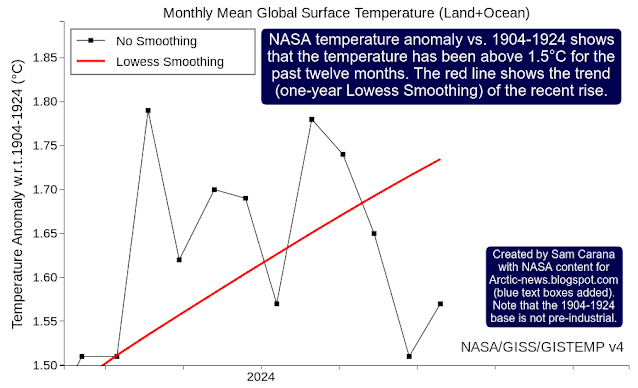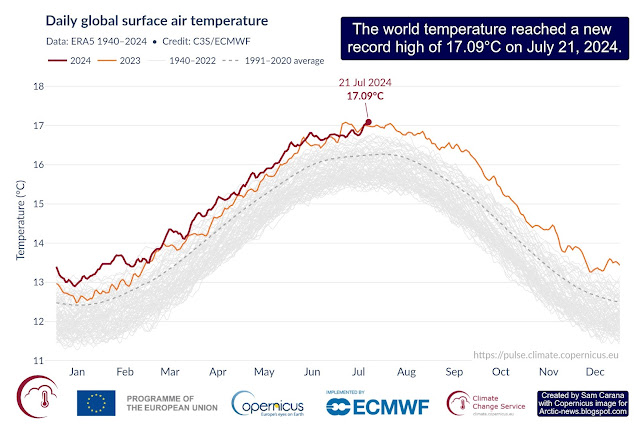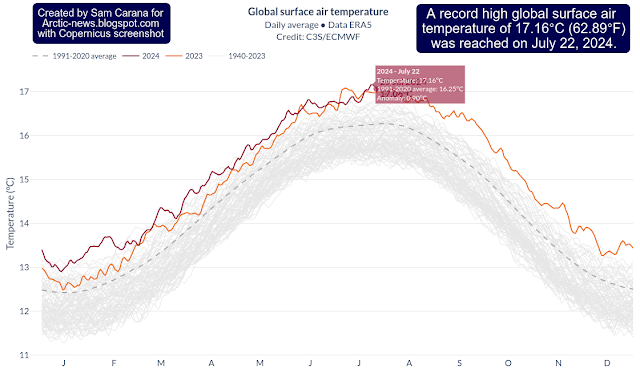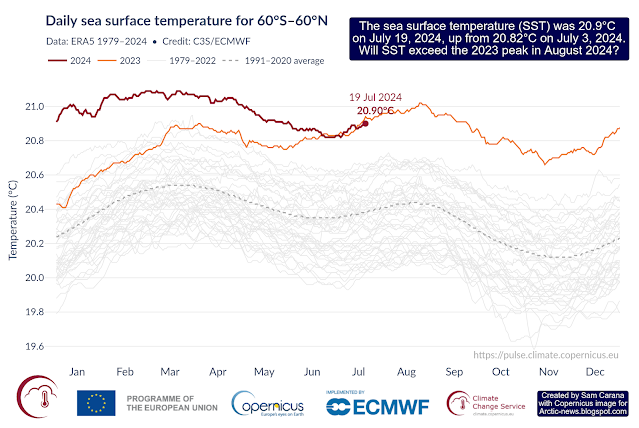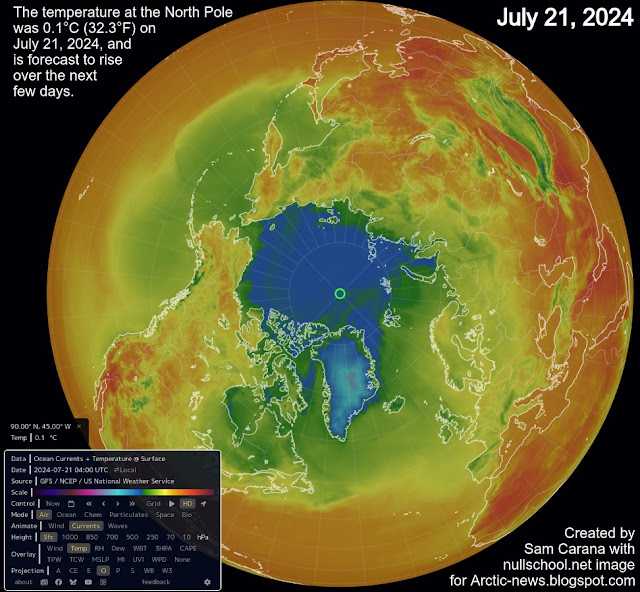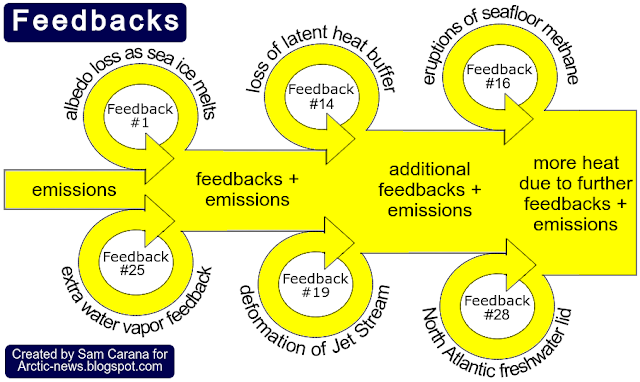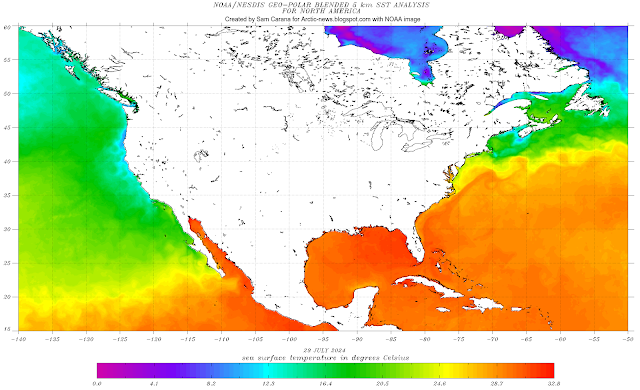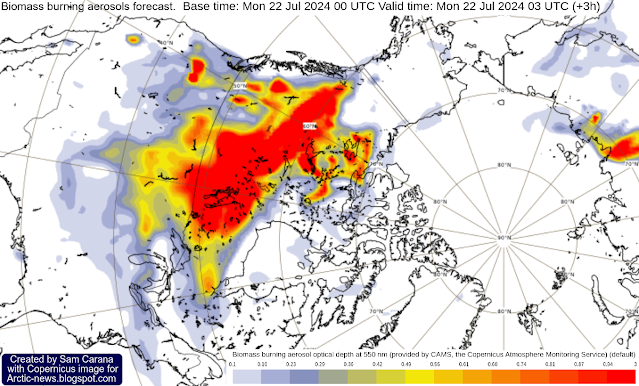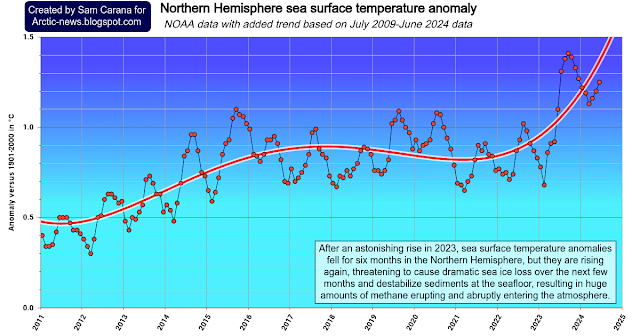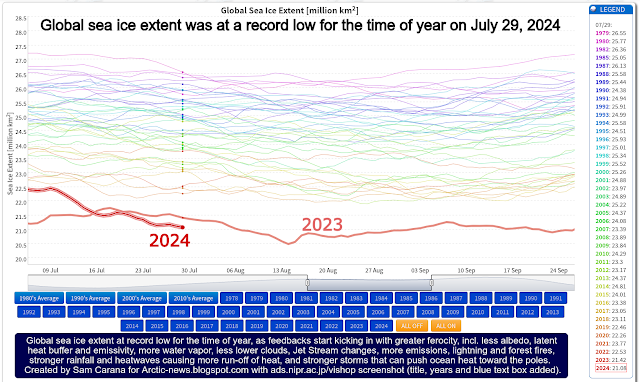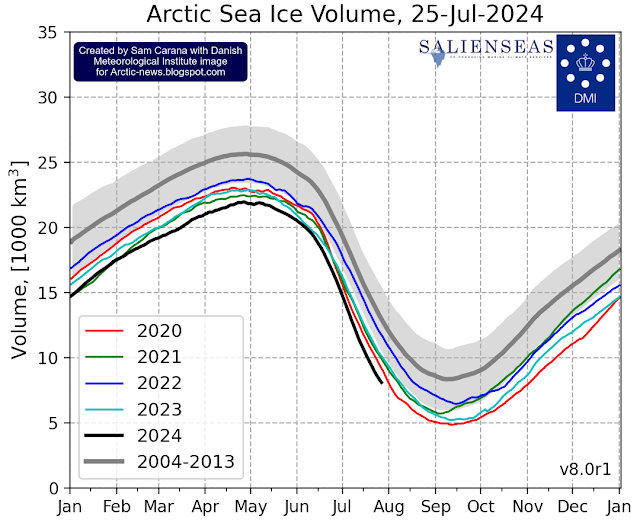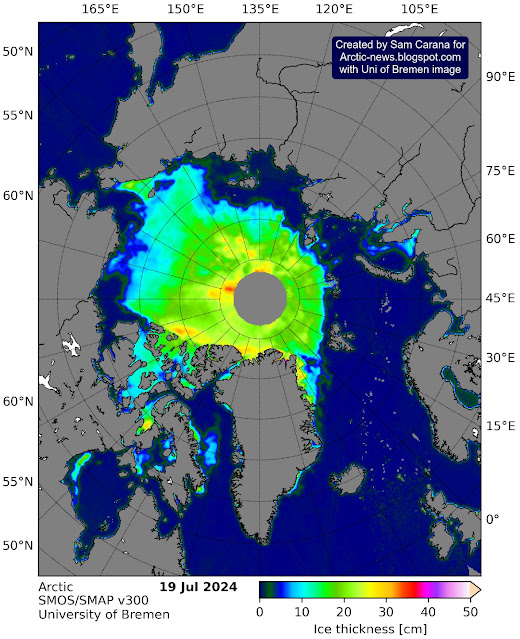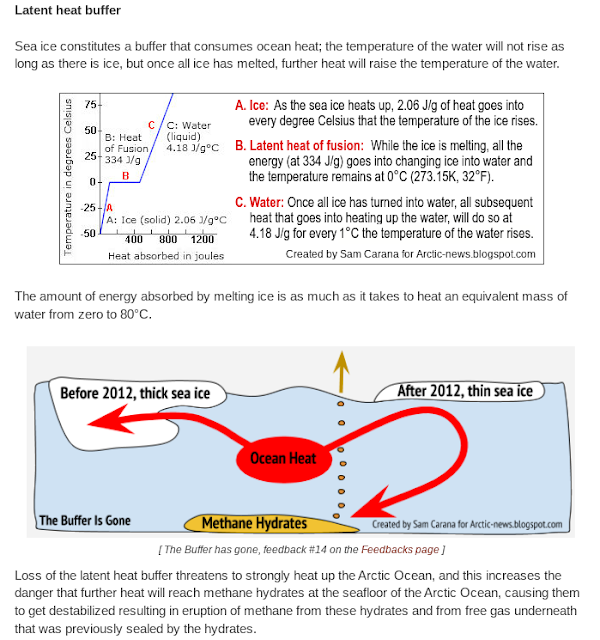Temperatures are rising
The NASA temperature anomaly vs. 1904-1924 shows that the temperature has been above 1.5°C for the past twelve months, as illustrated by the image below. The red line shows the trend (one-year Lowess Smoothing) associated with the rapid recent rise.
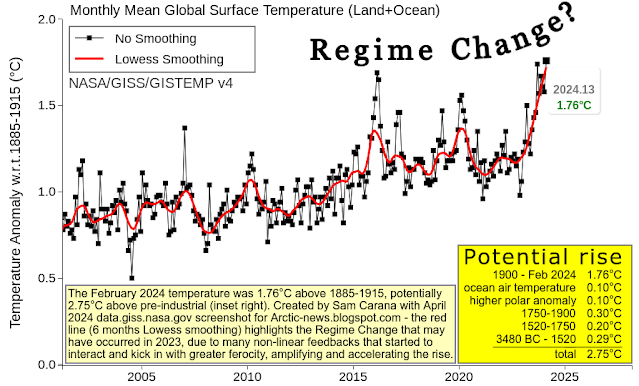 |
| [ from earlier post ] |
On July 21, 2024, a record high global temperature was reached of 17.09°C (62.76°F). The previous record, 17.08°C, was reached on July 6, 2023.
• Loss of the latent heat buffer – as sea ice disappears, heat can no longer be consumed by the process of melting, and the heat will instead go into increasing the temperature (feedback #14)
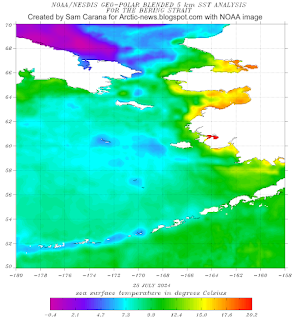 |
| [ click on images to enlarge ] |
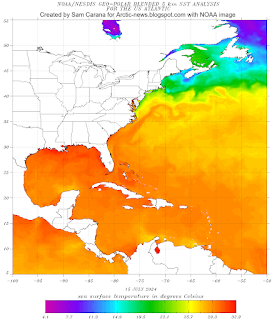 |
| [ click on images to enlarge ] |
The image on the right shows hot water getting pushed along the path of the Gulf Stream from the Gulf of Mexico toward the Arctic Ocean. The image shows sea surface temperatures as high as 32.9°C (91.22°F) on July 15, 2024.
• Eruptions of seafloor methane – as more heat reaches the seafloor of the Arctic Ocean, sediments and hydrates contained in them destabilize, resulting in methane releases (feedback #16)
• forest fires cause emissions that cause more heat to be trapped;
• forest fires contributed to the 2023 global net land carbon dioxide sink to be the weakest since 2003;
• forest fires cause emissions of black carbon that darkens the surface, resulting in less sunlight getting reflected back into space.
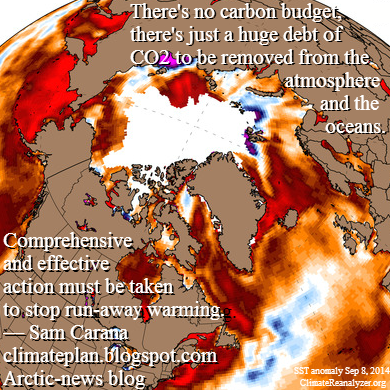 |
| [ image from a 2014 post ] |
Indeed, action is needed to reduce concentrations of carbon both in oceans and in the atmosphere. On land, the soil carbon content needs to increase, which can be achieved by methods such as pyrolysis of biowaste and adding the resulting biochar to the soil, which will reduce fire hazards, sequester carbon and support the presence of moisture & nutrients in the soil and the health & growth of vegetation, as discussed at the Climate Plan group and the biochar group.
After an astonishing rise in 2023, sea surface temperature anomalies fell for six months in the Northern Hemisphere, but they are rising again, threatening to cause dramatic sea ice loss over the next few months and destabilize sediments at the seafloor, resulting in huge amounts of methane erupting and abruptly entering the atmosphere.
The paragraph below is from an earlier post:
Sea ice loss results in less sunlight getting reflected back into space and instead getting absorbed by the ocean and the impact of Antarctic sea ice loss is even stronger than Arctic sea ice loss, as Antarctic sea ice is located closer to the Equator, as pointed out by Paul Beckwith in a video in an earlier post. A warmer Southern Ocean also comes with fewer bright clouds, further reducing albedo, as discussed here and here. For decades, there still were many lower clouds over the Southern Ocean, reflecting much sunlight back into space, but these lower clouds have been decreasing over time, further speeding up the amount of sunlight getting absorbed by the water of the Southern Ocean, and this ‘pattern effect‘ could make a huge difference globally, as this study points out. Emissivity is a further factor; open oceans are less efficient than sea ice when it comes to emitting in the far-infrared region of the spectrum (feedback #23 on the feedbacks page).
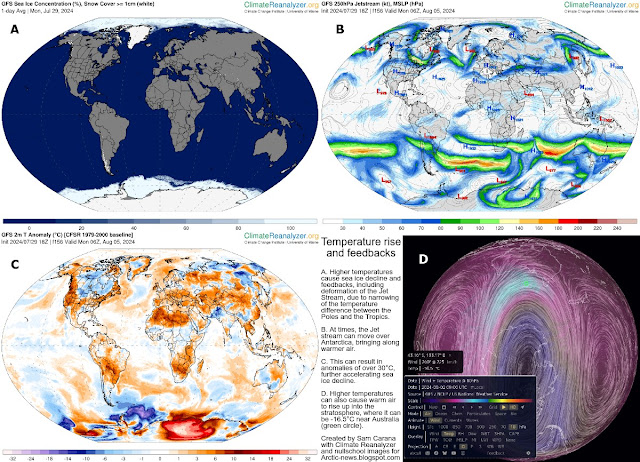 |
| [ click on images to enlarge ] |
The temperature rise comes with sea ice decline and feedbacks, as illustrated by the above image.
A. Higher temperatures cause sea ice decline and feedbacks, including deformation of the Jet Stream, due to narrowing of the temperature difference between the Poles and the Tropics.
B. At times, the Jet stream can move over Antarctica, bringing along warmer air.
C. This can result in anomalies of over 30°C, further accelerating sea ice decline.
D. Higher temperatures can also cause warm air to rise up into the stratosphere, where it can be -16.5°C near Australia (green circle).
The image below, adapted from the Danish Metereological Institute, indicates that Arctic sea ice volume is at a record low for the time of year, as it has been for most of the year. At the same time, Arctic sea ice extent is not the lowest on record for the time of year; on July 25, 2024, Arctic sea ice extent was third lowest on record, extent was lower only in 2019 and 2020 of all years on record. See discussion at facebook. The implication is that sea ice must be very thin.
The above images shows that most of the thicker Arctic sea ice has melted, i.e. the latent heat buffer has virtually disappeared. This and further feedbacks and events (e.g. high sunspots) may cause temperatures to keep rising, even while La Niña is expected to prevail in Aug-Oct 2024.
The screenshot below, from an earlier post, further illustrates the danger.
Climate Emergency Declaration
The situation is dire and the precautionary principle calls for rapid, comprehensive and effective action to reduce the damage and to improve the situation, as described in this 2022 post, where needed in combination with a Climate Emergency Declaration, as discussed at this group.
Links
• NASA – datasets and images
https://data.giss.nasa.gov
https://climatereanalyzer.org
• Pre-industrial
https://arctic-news.blogspot.com/p/pre-industrial.html
• Low latency carbon budget analysis reveals a large decline of the land carbon sink in 2023 – by Piyu Ke et al.
https://www.facebook.com/groups/arcticnews/posts/10161545190814679
• Arctic Data archive System – National Institute of Polar Research – Japan
https://ads.nipr.ac.jp/vishop
• NOAA – Office of Satellite and Product Operations (OSPO)
• NOAA – National Centers for Environmental Information – Climate at a Glance – Global Time Series
https://www.ncei.noaa.gov/access/monitoring/climate-at-a-glance/global/time-series/nhem/ocean/1/0/1850-2024
• Danish Meteorological Institute – Arctic sea ice volume and thickness
https://ocean.dmi.dk/arctic/icethickness/thk.uk.php
• University of Bremen – Arctic sea ice
https://seaice.uni-bremen.de/start
• Sunspots
https://arctic-news.blogspot.com/p/sunspots.html
Current Status and Predictions
https://arctic-news.blogspot.com/2022/10/transforming-society.html
• Climate Plan
https://arctic-news.blogspot.com/p/climateplan.html
• Climate Emergency Declaration
https://arctic-news.blogspot.com/p/climate-emergency-declaration.html

